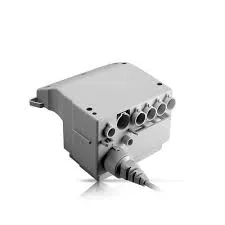The Versatility of Black Self-Amalgamating Tape
In the world of electrical and mechanical repairs, one product stands out for its versatility and ease of use black self-amalgamating tape. Also known as self-fusing tape, this specialized adhesive tape has become an essential item for professionals and DIY enthusiasts alike, thanks to its unique properties that provide reliable insulation, sealing, and protection in a variety of applications.
Understanding Self-Amalgamating Tape
Self-amalgamating tape is constructed from a rubber compound that has exceptional insulating properties and adheres to itself when stretched and wrapped around an object. Unlike traditional adhesive tapes, which utilize a sticky backing to adhere to surfaces, self-amalgamating tape forms a solid bond by entwining molecules into one another when pressed together. This means that once applied, the tape essentially becomes part of the object it is wrapped around, creating a strong, waterproof, and durable seal.
Key Features and Benefits
1. Electrical Insulation One of the primary uses of black self-amalgamating tape is in the electrical industry. It is ideal for insulating electrical connections and wiring, as it can withstand high temperatures and voltages. Its self-sealing nature enhances protection against moisture and dust, which can lead to electrical failures.
2. Waterproofing The tape’s ability to form a watertight seal makes it perfect for outdoors applications. Whether you need to protect an exposed wire, wrap water lines, or cover any type of connection susceptible to moisture, self-amalgamating tape offers reliable waterproofing, ensuring that the integrity of the connection remains intact.
3. Easy Application Another significant advantage is its ease of application. Unlike some tapes that require careful alignment and pressure to stick, self-amalgamating tape can be stretched and applied quickly, even in challenging environments or awkward angles. This makes it especially useful in urgent repair situations where time is of the essence.
black self amalgamating tape

4. Chemical Resistance Black self-amalgamating tape is not only resistant to water but also to a range of chemicals. This property allows it to be used in varied conditions across industries, including automotive, aerospace, and marine applications, where exposure to oils, fuels, and other harsh substances is common.
5. Temperature Resistance The ability of self-amalgamating tape to withstand extreme temperatures (both hot and cold) is another notable feature. This resilience ensures that its performance remains consistent in harsh environmental conditions, extending the life of repairs made with the tape.
Common Applications
Due to its versatility, black self-amalgamating tape finds use in numerous applications. In automotive repair, it may be used to insulate battery terminals or repair wiring harnesses. In marine environments, boat owners use it to seal and protect wiring and connections from the harsh elements encountered on the water. Additionally, it is favored in telecommunications for insulating and bundling cables to enhance signal integrity and performance.
DIY enthusiasts have also adopted self-amalgamating tape for home improvement projects, from plumbing repairs to electrical work, due to its reliability and ease of use. Its ability to conform to irregular shapes makes it an optimal choice for securing and insulating irregularly shaped objects.
Conclusion
Black self-amalgamating tape is more than just a repair tool; it is a multifunctional solution that meets the demanding needs of both professionals and hobbyists across various fields. Its unique adhesive properties, combined with electrical insulation, waterproofing, and chemical resistance, make it an invaluable resource. Whether you are an electrician, a mechanic, or a DIY home improver, keeping a roll of self-amalgamating tape handy can save you time and resources while ensuring that your repairs are durable and effective.
In summary, self-amalgamating tape's innovative design and capabilities not only enhance safety and performance in various applications but also reflect the advancements in material technology that continue to support our everyday needs in repair and maintenance.
-
XIANGFAN Rubber Tape-Ultimate Solutions for All Your Insulation NeedsNewsJun.24,2025
-
XIANGFAN Rubber Tape-Protection for Industrial and Residential ApplicationsNewsJun.24,2025
-
XIANGFAN Rubber Tape: Superior Safety and Sealing for Demanding EnvironmentsNewsJun.24,2025
-
XIANGFAN Rubber Tape: Reliable Solutions for Every Electrical ChallengeNewsJun.24,2025
-
XIANGFAN Electrical & Industrial Tape: Powering Reliability Across IndustriesNewsJun.24,2025
-
XIANGFAN Electrical & Industrial Tape: Excellence in Every ApplicationNewsJun.24,2025
